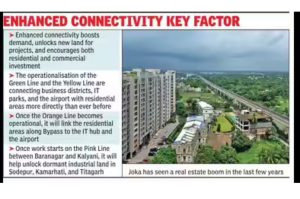Kolkata Metro Expansion: Kolkata, a city with a deep history of culture and commerce, is undergoing a new wave of transformation powered by infrastructure. The expansion of the Kolkata Metro network, especially the Purple and Blue Line extensions, is not just a transport upgrade but a catalyst for real estate growth across the metropolitan region. Realtors, urban planners, and investors believe that the metro is unlocking dormant land parcels, boosting property values, and redrawing the residential and commercial maps of the city.
Kolkata Metro Expansion: The Power of Connectivity
Metro connectivity has long been associated with urban expansion worldwide, and Kolkata is no different. Each kilometer of new line is directly translating into new demand zones for housing and commercial development.
- Purple Line: Connecting Joka to the city’s core, with planned extension to IIM-Calcutta and further toward Diamond Park, is turning Behala, Thakurpukur, and Joka into emerging residential hubs.
- Blue Line: Traditionally serving as Kolkata’s lifeline from Noapara to New Garia, its extension links now make suburban living more attractive and convenient.
With reduced travel times, improved accessibility to workplaces, and proximity to educational and healthcare institutions, realtors say peripheral suburbs are turning into prime investment zones.
Realtors’ Optimism
Real estate associations like CREDAI West Bengal and developers from Merlin Group, Purti Realty, and Prasad Group highlight that metro expansion is changing how buyers perceive location value.
- Commercial Real Estate: Office leasing in Salt Lake Sector V and New Town has touched record highs. With metro connectivity, these areas are increasingly compared to Dalhousie Square and Park Street—the city’s historic business districts.
- Residential Projects: Suburbs such as New Barrackpore, Madhyamgram, Barasat, Joka, and Behala are seeing an uptick in new launches. Mixed-use and transit-oriented developments are being pitched as the next growth story.

Historical Evidence of Growth
Past metro expansions already provide a blueprint:
- Blue Line Extension in mid-2000s: Triggered rapid housing growth between Tollygunge and New Garia.
- Purple Line (Joka–Taratala segment): Boosted demand in Behala Chowrasta, Sakherbazar, and Joka.
- Upcoming Yellow Line: With the Noapara–Airport stretch operational, property appreciation is already being tracked around Dum Dum, Lake Town, and Baguiati.
This ripple effect is expected to repeat with every future extension, from Baranagar–Barrackpore (Pink Line proposal) to Kidderpore and Diamond Harbour Road.
Impact on Suburban Markets
The city’s peripheries—once considered too far for daily commuting—are now becoming commuter-friendly residential clusters.
- Joka & Thakurpukur: Affordable housing with growing middle-class interest.
- Madhyamgram & Barasat: Improved metro links expected to ease airport connectivity, boosting both rental and purchase demand.
- Howrah: With upcoming interchanges, it is evolving from an industrial town into a mixed-use hub with commercial and residential balance.
Commercial Real Estate Boom
Kolkata is attracting global capability centres (GCCs), IT companies, and BFSI firms thanks to better infrastructure. Realtors expect 2 million sq ft of office leasing in 2025, a decade-high number. Metro access ensures employee convenience, making new business districts competitive with other Indian metros like Bengaluru or Hyderabad.
Planned Infrastructure
Recent government tenders and announcements are solidifying these expectations:
- Purple Line IIM-Calcutta Extension: ₹377 crore project, with a 30-month deadline.
- Kidderpore Station Land Clearance: Opening up new alignments and easing bottlenecks.
- Future Pink & Yellow Line Extensions: Tapping industrial belts in Titagarh, Kamarhati, and Sodepur.
Each of these projects adds new nodes of real estate growth, ensuring the city doesn’t remain lopsided in development.
Wider Economic & Social Benefits
- Job Creation: Construction of new metro corridors and residential projects generates direct and indirect employment.
- Urban Decongestion: Encourages migration from crowded city centers to well-connected suburbs.
- Green Growth: Metro travel reduces dependency on fossil fuels, aiding sustainable urban living.
- Social Equity: Affordable housing in metro-linked areas provides access to transport for middle and lower-middle-income households.
Concerns & Challenges
Despite the optimism, challenges remain:
- Project Delays: Land acquisition and funding issues often slow down metro work.
- Affordability vs. Speculation: Rising property prices may push out lower-income residents from certain suburbs.
- Last-Mile Connectivity: Metro access is only as strong as feeder services like buses, autos, and e-rickshaws.
Urban planners stress the need for integrated development, where metro projects are matched with supporting infrastructure.
Conclusion
The Kolkata Metro expansion is not just a transport project—it is a city-shaping exercise. Realtors, investors, and urban planners unanimously agree that it will define how the city grows in the coming decades. With improved connectivity, suburban and peripheral areas are emerging as the new epicentres of both residential and commercial development.
As the Purple and Blue Line extensions progress, Kolkata is poised for a real estate renaissance where infrastructure leads and growth follows.

